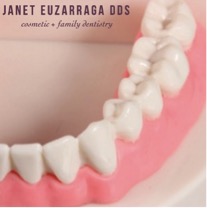 Dr. Janet Euzarraga, DDS, and her team want to help YOU “brush” up on your oral health! Read on to learn more about how each and every tooth – from canines to incisors to molars – plays an important role in contributing to your oral (and overall) health!
Dr. Janet Euzarraga, DDS, and her team want to help YOU “brush” up on your oral health! Read on to learn more about how each and every tooth – from canines to incisors to molars – plays an important role in contributing to your oral (and overall) health!
Not Every Tooth is Created Equally
You have surely noticed that some teeth are larger, while others may be sharper or pointier. For good reason! Each tooth serves a unique purpose. Some teeth are highly effective in helping to break down food while others serve to guide your jaw and even aid you in speaking more clearly.
The main types of teeth that comprise your beautiful smile can be classified into three main groups: incisors, canines, and molars, of which we have premolars, molars, and wisdom teeth. They each perform a slightly different job but work together to contribute to oral health and a winning smile.
Incisors. There are four on top and four on the bottom of your bite. Incisors do the important work of fully breaking down your food as you chew and digest it. They also help you enunciate your speech correctly. For example, your tongue touches against your incisors when you pronounce certain letter sounds. Try it… just mouth the word “teeth” and you’ll feel your incisors at work!
Canines. Your four canines are adjacent to your incisors. Sometimes referred to as “fangs,” they are the sharpest and longest teeth in the mouth. They do the bulk of the work in tearing through and ripping up the food we bite, chew, and digest. Canines also help our speech, form the curve to our back teeth, and guide the jaw and teeth.
Premolars. Also known as bicuspids, we have a total of eight premolars with two situated behind each canine tooth. Our premolars primarily aid the incisors and canines in chewing and grinding up food and they also lend support to our facial muscles, contributing to a balanced, beautiful smile.
Molars. These teeth may reside in the back of the mouth, but they are the strongest of the strong! Our tongue helps push food toward the molars so that we can evenly crush up and digest what we eat. Molars also help support the cheeks and lend balance to the face.
Wisdom teeth. These teeth typically do not emerge until we are 18-20 years of age. They are typically removed because they can crowd or damage other teeth or harbor bacteria and infection because they are difficult to clean. Why do we have them? Many believe that our early ancestors needed them to survive on a diet of roots, nuts, and coarse meats. Today, most dentists – including Dr. E — recommend removal of wisdom teeth.
Now that you know the important role each tooth plays, be sure to properly care for your pearly whites because each one equally contributes to a healthy, beautiful smile!

